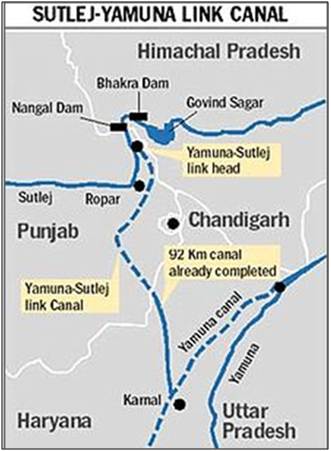In News:
- Recently, the Haryana Assembly has passed a resolution seeking completion of the Sutlej Yamuna Link Canal (SYL) Canal.
Background on SYL canal and dispute
Sharing of Ravi and Beas River waters:
- When Pubjab was not divided:
- In 1955, when the waters of the Ravi and Beas Rivers were calculated at 15.85 million acre feet (MAF). Out of this, the Centre had allocated 8 MAF to Rajasthan, 7.20 MAF to undivided Punjab, 0.65MAF to Jammu and Kashmir.
- The disputeregarding sharing of river water emerged after Punjab was reorganised in 1966, and the state of Haryana was created out of Punjab.
- After Haryana and Punjab were divided:
- After the separation of States, Punjab refused to share waters of Ravi and Beas (a tributary of Sutlej) with Haryana, citing the Riparian Principle.
- According to Riparian Principle, the owner of land adjacent to a waterbody has the right to use the water.
- In March 1976, when Punjab Reorganisation Act was implemented, the Centre notified fresh allocations, providing 3.5 MAF (out of 7.2 MAF given to Undivided Pubjab) to Haryana.
- Later, in 1981, the water flowing down Beas and Ravi was revised and estimated to be at 17.17 MAF (up from the earlier 15.85 MAF). Out of this, 4.22 MAF was allocated to Punjab (higher than before), 3.5 MAF to Haryana (same as earlier), and 8.6 MAF to Rajasthan.
SYL canal and dispute:
- In December 1981, an agreement was made among Punjab, Haryana and Rajasthan to reallocate the waters of Ravi and Beas in “overall national interest and for optimum utilisation of the waters”.
- To enable Haryana to use its share of the waters of the Sutlej river and its tributary, Beas, a canal linking the Sutlej with the Western Yamuna Canal, was planned.
- The 212-km canal (SYL) was supposed to carry Haryana’s share of water to its southern parts.
- 122 km of the canal was to pass through Punjab and the remaining 90 km was to pass through Haryana.

- In 1982, the then Prime Minister Indira Gandhi launched the construction of SYL in Patiala district of Punjab.
Progress of SYL canal:
- Haryana has completed its side of the canal, however, Punjab has continued to delay the construction for over three decades.
- The canal became a sensitive issue in Punjab, and with the rise of terrorism in the state in the 1980s and 1990s, the project was never completed.
- In 2002 and 2004, the Supreme Court ordered the completion of the canal in Punjab.
- In 2004, the Punjab assembly passed a law, which declared all inter-state agreements related to the sharing of Ravi and Beas waters, as invalid. However, in 2016 the Supreme Court invalidated (cancelled) this law.
- However, days after the Supreme Court’s decision, the Punjab government de-notified 5,376 acres of land that was acquired for canal and return it to its original owners free of cost.
In News:
- Recently, the Haryana Assembly has passed a resolution seeking completion of the Sutlej Yamuna Link Canal (SYL) Canal.
- The resolution said that the right of Haryana to share waters of Ravi and Beas rivers by the construction of the SYL Canal are historically, legally, judicially and constitutionally established over time.
Haryana’s Claim:
- Haryana government has already completed 92 km of canal in its land.
- Haryana argues that it has difficulties providing water for the irrigation purposes of the state, and has maintained that Punjab should comply with the Supreme Court orders.
- Haryana has been arguing that it is being denied its rightful share in the water as assessed by a tribunal.
- Haryana reportedly also faces a problem with drinking water in places where the underground water had depleted up to 1,700 feet.
Punjab’s Claim:
- Punjab has maintained that the quantum of water flowing through the Ravi and Beas rivers has decreased over time.
- It has been seeking a fresh tribunal to conduct another reassessment of the volume of the water.
- Also, Punjab is facing a severe water crisis and various reports has indicated that many areas of the state may go dry after 2029.
- As per reports, water in about 79% of the state’s area is over-exploited.










